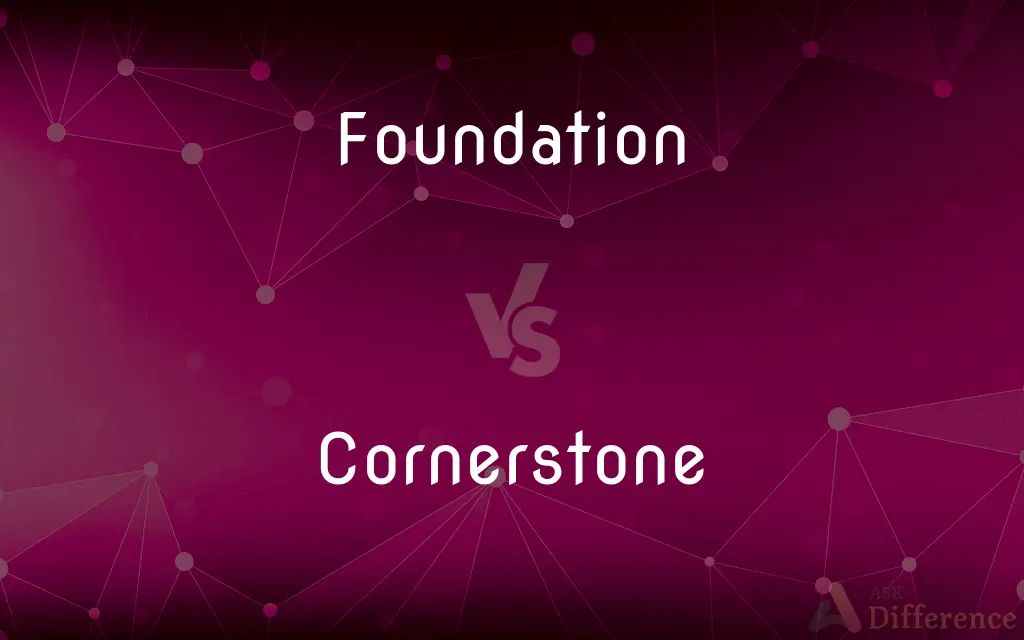Foundation vs. Cornerstone — What's the Difference?
By Fiza Rafique & Urooj Arif — Updated on February 29, 2024
A foundation is the underlying base that supports a structure, essential for stability and strength, while a cornerstone is a ceremonial stone set at the corner of a building, symbolizing its starting point and often bearing historical significance.

Difference Between Foundation and Cornerstone
Table of Contents
ADVERTISEMENT
Key Differences
The foundation of a building or structure is a critical element that distributes its weight to the ground, ensuring stability, strength, and durability. It is designed to prevent settling and protect against natural forces like earthquakes and floods. Foundations are engineered based on soil type, building weight, and environmental conditions, serving as the unseen but essential support for any construction.
The cornerstone, traditionally, is the first stone set in the construction of a masonry foundation, marking the starting point of a building. It often includes an inscription with the construction's date, and sometimes, time capsules or mementos are placed within it. While cornerstones were once crucial for setting the position and orientation of a building, their role has evolved to be more ceremonial and symbolic, representing the ideals, hopes, and aspirations associated with the construction.
Foundations and cornerstones differ significantly in their function and symbolism. The foundation is fundamentally practical, underpinning the entire structure, while the cornerstone carries symbolic weight, often commemorating the construction's significance and serving as a historical marker. This distinction highlights the foundation's role in the physical integrity of a building and the cornerstone's role in its cultural and historical identity.
Despite these differences, both elements are integral to the concept of building and construction. The foundation ensures that a building can stand and endure over time, while the cornerstone adds a layer of meaning and tradition to the construction process. In modern architecture, the use of a cornerstone is less common, yet its symbolic presence remains a testament to the importance of acknowledging and commemorating the beginnings of significant structures.
Understanding the distinction between foundation and cornerstone helps in appreciating the complexity and depth of construction practices, from the technical engineering of stable foundations to the cultural practices of laying cornerstones. This interplay between the practical and the symbolic enriches our understanding of architectural and construction traditions.
ADVERTISEMENT
Comparison Chart
Purpose
Provides stability and support to structures
Symbolizes the starting point and ideals of a structure
Function
Distributes the building's weight to the ground
Ceremonial role, often includes inscriptions
Composition
Concrete, steel, stone, or other materials
Typically a single stone or block
Placement
Under the entire structure for support
At a corner, traditionally the first stone placed
Significance
Essential for structural integrity
Symbolic, representing historical or cultural significance
Modern Usage
Fundamental in all constructions
Mostly ceremonial and less commonly used
Role in Construction
Practical and technical
Symbolic and commemorative
Compare with Definitions
Foundation
Constructed from various materials.
The building's foundation was poured concrete, reinforced with steel.
Cornerstone
Often bears inscriptions.
The cornerstone contained the date of construction and the architect's name.
Foundation
Supports the entire structure.
The ancient ruins revealed the foundation's role in the building's longevity.
Cornerstone
Symbolizes ideals and beginnings.
The laying of the cornerstone symbolized the community's hopes for the new library.
Foundation
Designed based on environmental conditions.
The foundation was engineered to withstand earthquakes.
Cornerstone
The first stone set in construction.
The cornerstone was laid with a ceremony, marking the project's beginning.
Foundation
The base that supports a structure.
The engineers designed a deep foundation to ensure the skyscraper's stability.
Cornerstone
Less common in modern construction.
Though now symbolic, the cornerstone tradition adds historical significance.
Foundation
Key for durability and strength.
A solid foundation is crucial for the long-term endurance of any home.
Cornerstone
May include time capsules.
A time capsule was placed within the cornerstone, to be opened by future generations.
Foundation
The lowest load-bearing part of a building, typically below ground level
Foundations were being dug for a block of flats
Build the arch resting on top of this solid foundation
Cornerstone
The cornerstone (or foundation stone or setting stone) is the first stone set in the construction of a masonry foundation. All other stones will be set in reference to this stone, thus determining the position of the entire structure.
Foundation
The action of establishing an institution or organization
The foundation of a civil service college
Cornerstone
An important quality or feature on which a particular thing depends or is based
A national minimum wage remained the cornerstone of policy
Foundation
The act of founding, especially the establishment of an institution with provisions for future maintenance.
Cornerstone
A stone forming the base at the corner of a building.
Foundation
The basis on which something is grounded;
There is little foundation for his objections
Cornerstone
A stone that forms the base of a corner of a building, joining two walls.
Foundation
An institution supported by an endowment
Cornerstone
A stone at the corner of a building uniting two intersecting walls; a quoin.
Foundation
The fundamental assumptions from which something is begun or developed or calculated or explained;
The whole argument rested on a basis of conjecture
Cornerstone
Such a stone when inscribed with the date of the start of the construction of the building.
Foundation
Lowest support of a structure;
It was built on a base of solid rock
He stood at the foot of the tower
Cornerstone
Such a stone used ceremonially, often inscribed with the architect's and owner's names, dates and other details.
Cornerstone
A stone in the exterior of a large and important building; usually carved with a date and laid with appropriate ceremonies
Cornerstone
A stone at the outer corner of two intersecting masonry walls
Common Curiosities
What does a cornerstone represent?
It represents the commencement of construction and often symbolizes the building's cultural, historical, or emotional significance.
How are modern foundations different from ancient ones?
Modern foundations use advanced materials and engineering techniques to better withstand environmental forces and support taller, heavier structures.
What is the main difference between a foundation and a cornerstone?
The foundation is the structural base of a building, essential for stability, while a cornerstone is a ceremonial stone marking the construction's beginning.
Can a building have a foundation without a cornerstone?
Yes, a building must have a foundation for structural support, but a cornerstone is optional and ceremonial.
Why is the foundation important for a building?
It provides the necessary support to distribute the building's weight evenly, preventing settling and structural damage.
Is the cornerstone still used in construction today?
While its practical purpose has diminished, the cornerstone is still used in ceremonial contexts to commemorate the significance of new buildings.
How do engineers decide on the type of foundation for a building?
Engineers consider soil type, building weight, environmental conditions, and local building codes to design the most suitable foundation.
Can the cornerstone be part of the foundation?
Historically, the cornerstone was part of the foundation, but today it is more symbolic and not essential to the foundation's structure.
What might be included in a cornerstone time capsule?
Items often include newspapers, photographs, coins, and documents related to the building's construction and purpose.
How is the cornerstone ceremony conducted?
It typically involves placing the stone with inscriptions and sometimes depositing items in a time capsule, accompanied by speeches and celebrations.
What is the significance of the foundation in architecture?
It is fundamental to the structural integrity and durability of buildings, shaping architectural possibilities and limitations.
What happens if a foundation fails?
Foundation failure can lead to serious structural damage, including cracks, leaning, and in extreme cases, building collapse, highlighting the need for careful planning and construction.
What materials are used for foundations?
Common materials include concrete, reinforced steel, and sometimes stone, depending on the building's requirements and location.
Does every building have a symbolic cornerstone?
Not every building has a cornerstone; its use is more common in buildings with significant cultural, historical, or institutional importance.
How does the foundation affect a building's longevity?
A well-designed foundation ensures a building can withstand environmental stresses over time, crucial for its longevity and safety.
Share Your Discovery

Previous Comparison
Author vs. Narrator
Next Comparison
Discotheque vs. DiscoAuthor Spotlight
Written by
Fiza RafiqueFiza Rafique is a skilled content writer at AskDifference.com, where she meticulously refines and enhances written pieces. Drawing from her vast editorial expertise, Fiza ensures clarity, accuracy, and precision in every article. Passionate about language, she continually seeks to elevate the quality of content for readers worldwide.
Co-written by
Urooj ArifUrooj is a skilled content writer at Ask Difference, known for her exceptional ability to simplify complex topics into engaging and informative content. With a passion for research and a flair for clear, concise writing, she consistently delivers articles that resonate with our diverse audience.













































